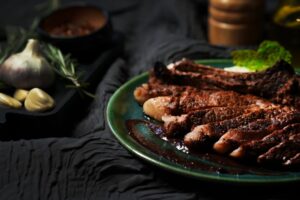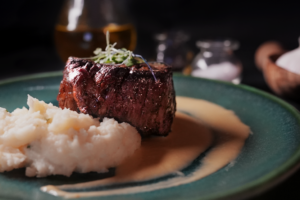Your perfect steak relies on more than your favorite cut of meat to develop a meal that will allow you to savor every bite. Achieving the right doneness is an art that takes your favorite steak up a notch for a flavorful cut of meat sure to delight your taste buds. Yet, reaching the perfect doneness isn’t always easy. Our guide can help you align your culinary skills with personal preferences to reach the ideal level of internal steak temperature.
6 Most Common Degrees of Doneness
Whether you’re ordering at your favorite restaurant or grilling steaks at home, the first order of business is understanding the most common degrees of doneness. Each degree requires a specific temperature to achieve the right texture and flavor.
- Blue: When you’re seeking the rarest steak possible, blue is what you want. At the lowest end of the rare steak scale, a blue steak is pulled off the heat as soon as it reaches 120 degrees F. The outside of a blue rare steak is charred while the middle is still cool.
- Rare: A rare steak can have an internal temperature range from 120 – 130 degrees F. The center will remain red, juicy, and relatively cool while the edges are charred. The meat will be soft and tender throughout.
- Medium Rare: A medium-rare steak raises the internal temperature to 130 – 135 degrees F. The center will be dark pink instead of red, and the edges will be browned. The meat offers a little more resistance, and the fat has melted and distributed flavor throughout. Medium rare is the most popular steak doneness.
- Medium: A medium steak reaches an internal temperature of 140 – 145 degrees F. The inside of the steak will be pink with no visible red hue and hot throughout. This level of doneness has a little more resistance while remaining tender.
- Medium Well: With an internal temperature of 150 – 155 degrees F, a medium well steak is hot and only has a slightly pink hue in the very center and minimal color around the edges. A medium-well steak is quite firm while remaining juicy.
- Well: A well-done steak is cooked to an internal temperature of 160 – 165 degrees F. No pink is left in the middle and the center is hot throughout. This steak is firm and has a dryer texture. As a result, it’s often eaten with steak sauce.
Factors that Influence the Perfect Steak Temperature
You may be surprised to realize that you don’t have a singular preference when it comes to steak doneness. Different factors can change the way your steak tastes at a specific level of doneness, and these factors influence the best steak temperature.
- Type of Steak: Lean meats, like sirloin or tenderloin, have a lower fat content which can also make them less juicy. As a result, they’re more likely to be preferred rare than fattier cuts of meat, like a rib eye.
- Cooking Method: Direct heat and reverse sear are the most popular ways to cook steak. The direct heat method requires you to cook the meat over high heat the entire time, while reverse searing uses low heat until the desired internal temperature is almost met. Since direct heat is less predictable, you may want to choose a rarer temperature.
- Thickness: Like lean meats, thinner cuts of meat are easier to overcook and dry out. People often prefer thinner cuts at rare temperatures and thicker cuts at a higher level of doneness.
SEAR Black Hills Steakhouse: A Cut Above the Rest
Sometimes, the perfect steak is one you don’t have to cook yourself. When you want to relax and enjoy your favorite steak cooked to the perfect level of doneness, let the expert chefs at SEAR Black Hills Steakhouse cook it for you. Make a reservation at SEAR Black Hills to enjoy your favorite cut of steak just the way you like it. Stop in and visit us on a date night, with a crowd, or on a regular evening when you have a craving for steak in Rapid City, SD.




